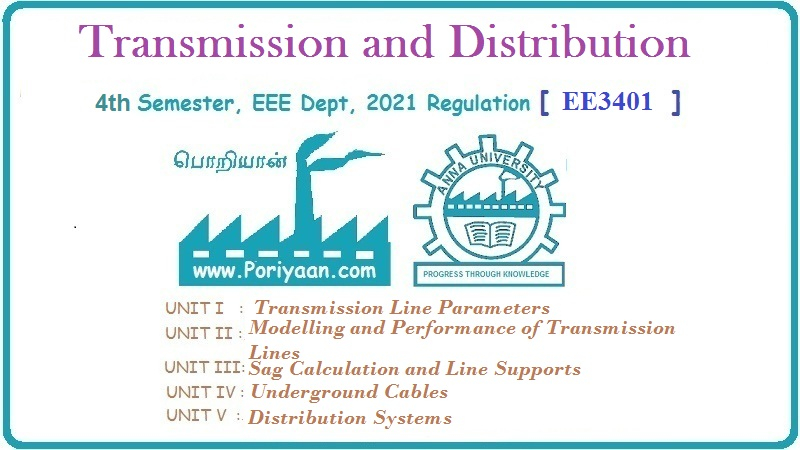Transmission and Distribution: AU Solved Paper
AU Solved Paper
Semester - IV (EEE) (Regulation 2013)
Transmission and Distribution: AU Solved Paper : Semester - IV (EEE) (Regulation 2013)
AU Solved Paper [71773]
May - 2017
Transmission and
Distribution
Semester - IV (EEE)
(Regulation 2013)
[Time : Three Hours]
[Maximum Marks : 100]
Answer ALL questions
PART A - (10 × 2 = 20 Marks)
Q.1 Mention the transmission voltages
that are followed in Tamil Nadu.
[Refer Two Marks Q.42 of Chapter - 7]
Q.2 What is ring main system ?
[Refer Two Marks Q.36 of Chapter - 7]
Q.3 State skin effect in transmission
lines. Mention its effect on the resistance of the line.
[Refer Two Marks Q.3 of Chapter - 1]
Q.4 State
different types of overhead conductors.
[Refer section 1.4]
Q.5 What
is Ferranti effect ?
[Refer Two Marks Q.6 of Chapter - 2]
Q.6 Write down the significance of SIL
on transmission line.
[Refer Two Marks Q.21 of Chapter - 2]
Q.7 Specify the different types of
insulators.
[Refer Two Marks Q.7 of Chapter - 5]
Q.8 What are the two different methods
of grading of cables ?
[Refer Two Marks Q.15 of Chapter - 6]
Q.9 Enlist any two factors that affect
sag in the transmission line.
[Refer Two Marks Q.5 of Chapter - 4]
Q.10 Write down the types of grounding.
[Refer Two Marks Q.10 of Chapter - 8]
PART B - (5 × 13 = 65 Marks)
Q.11 a) Explain the structure of
electric power syatem in detail.
[Reier section 1.2] [8]
OR
b) i) Compare the overhead and
underground distribution system.
[Refer section 1.3.3] [8]
ii) State the advantages of interconnected
system.
[Refer section 7.6.4] [5]
Q.12 a) Explain the factors affecting
corona loss and methods of reducing corona loss.
[Refer section 3.3]
OR
b) i) Explain the advantages of bundled
conductors when used for overhead lines.
[Refer section 1.4.16.1] [4]
ii) Determine the inductance of a 3
phase line opearating at 50 Hz and the conductors are arranged as shown below.
The conductor diameter is 0.7 cm.
[Refer example 1.19.6] [9]

Q.13 a) What are the different methods
available for voltage control and explain any one method.
[Refer section 7.18]
OR
b) i) Explain the meaning of performance
of lines.
[Refer section 2.4] [5]
ii) A single phase 50 Hz generator
supplies an inductive load of 6 MW at 0.8 pf lagging by means of an overhead
line 15 km long. The line resistance and inductance are 0.02 ohm/km and 0.85
mH/km. The voltage at the receiving end is 11 kV. Determine the sending end
voltage and voltage regulation.
[Refer example 2.5.1] [8]
Q.14 a) What are the different types of
testing of insulators ? Explain any one method.
[Refer section 5.7]
OR
b) Write short notes on :
i) Properties of insulation material
used for cable.
[Refer section 6.5.1] [5]
ii) The capacitance per kilometer of a 3
phase belted core cable is 0.2 micro farad/km between two cores with the third
core connected to sheath. Calculate the kVA. The supply voltage 6.6 kV and 30
km long.
[Refer example 6.9.4] [8]
Q.15 a) Describe the different types of
substation layouts and list few advantages of GIS.
[Refer sections 8.5, 8.6 and 8.9.1]
OR
b) Explain the key points to be
considered for tower spotting. Also list the basic types of tower based on
circuits used.
[Refer sections 4.9 and 4.11]
PART C - (1 × 15 = 15 Marks)
Q.16 a) A 400 V, 3 phase 4 wire service
mains supplies a star connected load. The resistance of each line is 0.1 ohm
and that of the neutral 0.2 ohm. The load impedances are ZR - (6 + j 9), Zy - 8
ohms and ZB - (6 - j 8). Calculate the violtage across each load impedance and
current in the neutral. Phase sequence RYB.
[Refer example 7.13.4]
OR
b) Explain your understanding about
transmission of power and distribution of power.
[Refer sections 1.2 and 1.3]
Transmission and Distribution: AU Solved Paper : Tag: : Semester - IV (EEE) (Regulation 2013) - AU Solved Paper
Related Topics
Related Subjects
Transmission and Distribution
EE3401 TD 4th Semester EEE Dept | 2021 Regulation | 4th Semester EEE Dept 2021 Regulation
